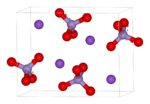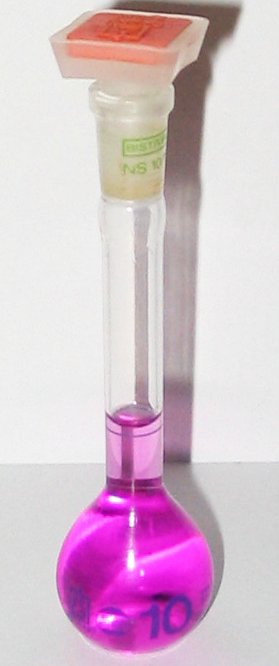Potassium permanganate facts for kids
| Potassium permanganate | |
|---|---|
  |
|
| General | |
| Other names | Potassium manganate(VII) |
| Molecular formula | KMnO4 |
| Molar mass | 158.04 g/mol |
| Appearance | black crystals;
bright purple in solution |
| CAS number | [7722-64-7] |
| Properties | |
| Density and phase | 2.703 g/cm³, solid |
| Solubility in water | 6.38 g/100 ml (20 °C) |
| Melting point | 270 °C decomp. |
| Thermodynamic data | |
| Standard enthalpy of formation ΔfH°solid |
−813.4 kJ/mol |
| Standard molar entropy S°solid |
171.7 J.K−1.mol−1 |
| Hazards | |
| EU classification | Oxidant (O) Harmful (Xn) Dangerous for the environment (N) |
| NFPA 704 | |
| Related compounds | |
| Other anions | Potassium hypomanganate |
| Other cations | Sodium permanganate |
| Related compounds | Potassium manganate Manganese heptoxide |
| Except where noted otherwise, data are given for materials in their standard state (at 25 °C, 100 kPa) See Wikipedia:Disclaimer. |
|
Potassium permanganate is a fascinating chemical compound. It is made of potassium, manganese, and oxygen. Its chemical formula is KMnO4. This means it has one potassium atom, one manganese atom, and four oxygen atoms.
It is also known as permanganate of potash or Condy's crystals. Potassium permanganate is a very strong oxidizing agent. This means it likes to take electrons from other chemicals. When you dissolve it in water, it creates beautiful purple solutions. If the water evaporates, it leaves behind shiny purple-black crystals. It doesn't have a smell, but it has a sweet taste.
Contents
History of Potassium Permanganate
Early Discoveries
The story of potassium permanganate began in 1659. A German chemist named Johann Rudolf Glauber was experimenting. He melted a mix of a mineral called pyrolusite and potassium carbonate. When he dissolved this new material in water, it turned green. This green solution was potassium manganate.
Slowly, the solution changed color to violet, which was potassium permanganate. Then it turned red. This was the first time anyone had described how to make potassium permanganate.
Condy's Crystals and Disinfectants
About 200 years later, a chemist in London named Henry Bollmann Condy became interested in disinfectants. He found that melting pyrolusite with sodium hydroxide and dissolving it in water created a solution that was good at killing germs. He got a patent for this solution and sold it as Condy's Fluid.
However, Condy's Fluid wasn't very stable. Condy fixed this by using potassium hydroxide instead of sodium hydroxide. This made a much more stable material. It could also be dried into a powder, which was just as good. This powder was called Condy’s crystals or Condy’s powder. Because it was easy to make, Condy tried to stop others from selling it.
In the past, photographers even used potassium permanganate in flash powder for their cameras.
Uses of Potassium Permanganate
Chemical Helper
Potassium permanganate is a powerful oxidizing agent. It is used in many ways, including as a disinfectant and to remove bad smells (a deodorizer). It helps create many different chemicals.
In waste water treatment, it helps get rid of hydrogen sulfide. This gas smells like rotten eggs and can be toxic. In analytical chemistry, a precise amount of KMnO4 can be used. It helps measure how much of another chemical is present in a process called titration. It is also used in the paper industry for wood pulp. Mixing potassium permanganate with formaldehyde can create a mild tear gas.
Changing Chemicals in Organic Synthesis
Weak solutions of KMnO4 can change alkenes into diols. This reaction is also used as a chemical test to find double or triple bonds in a molecule. When the reaction happens, the purple permanganate solution turns colorless. This test is sometimes called Baeyer's reagent.
Stronger solutions can change a methyl group on an aromatic ring. For example, it can turn toluene into benzoic acid.
Potassium permanganate can be used to make certain illegal substances. Because of this, its use and sale are carefully controlled by authorities.
Reactions with Acids
It's important to be very careful when mixing potassium permanganate with strong acids.
When concentrated sulfuric acid reacts with potassium permanganate, it can create manganese(VII) oxide. This substance can be explosive and is very dangerous. This reaction also produces ozone, which can even make paper soaked in alcohol catch fire.
- 6 KMnO4 + 9 H2SO4 → 6 MnSO4 + 3 K2SO4 + 9 H2O + 5 O3
If concentrated hydrochloric acid (HCl) is mixed with potassium permanganate, it produces chlorine gas.
- 2 KMnO4 + 16 HCl → 2 MnCl2 + 2 KCl + 8 H2O + 5 Cl2
The products formed from these reactions depend on how acidic or basic the solution is (its pH). In acidic solutions, permanganate changes into a faintly pink Mn2+ ion. In neutral solutions, it becomes brown manganese(IV) oxide. This is the substance that stains your skin if potassium permanganate touches it. In basic solutions, potassium permanganate changes into green potassium manganate.
Health and Medical Uses
- Weak solutions (0.25%) are used to treat mouth sores called canker sores.
- It can be used as a disinfectant for hands (about 1% solution).
- It helps treat mild skin conditions like pompholyx dermatitis or fungal infections on hands or feet.
- In histology, which is the study of tissues, a weak solution of acidified potassium permanganate is used. It helps remove melanin, a pigment, so scientists can see tissue details better.
- Potassium permanganate can help doctors tell the difference between types of amyloid deposits in body tissues.
Other Interesting Uses
- Solutions of KMnO4 have been used with 80% hydrogen peroxide to power rockets. It was called Z-Stoff for this use. This type of fuel is still used in torpedoes.
- A weak solution (10 mg/l) can remove snails from plants before putting them into a fresh-water aquarium.
- High-quality potassium permanganate is found at pool supply stores. In rural areas, it helps remove iron and hydrogen sulfide (which smells like rotten eggs) from well water.
- KMnO4 is often part of survival kits. It can be used with glycerine or a glucose tablet to start a fire. If you grind a glucose tablet, mix it with potassium permanganate, and rub it, it will burn. You can also mix it with anti-freeze from a vehicle to make fire, but this must be done very carefully. Dip some paper in anti-freeze, then add a small amount of potassium permanganate. It can also help sterilize water and wounds, making it very useful in emergencies.
- It is used to treat some parasitic diseases in fish.
- It helps treat drinking water.
- It can be an antidote for phosphorus poisoning.
- In some parts of Africa, it is used to disinfect vegetables like lettuce.
Hazards and Safety
Solid potassium permanganate is a very strong oxidizer. This means it can react strongly with other chemicals, especially those that are reducing agents. It should always be kept separate from them. Some reactions need a little bit of water to start. For example, if you mix powdered potassium permanganate and powdered sugar, adding a drop of water will make them ignite (but not explode) after a few seconds.
Weak solutions of KMnO4 are not dangerous. However, mixing KMnO4 with strong acids can create very dangerous products.
Potassium permanganate can stain skin and clothing a brown color. Always handle it with care. Stains on clothing can sometimes be washed away using acetic acid (like vinegar). Stains on skin usually disappear within 48 hours.
Images for kids
See also
 In Spanish: Permanganato de potasio para niños
In Spanish: Permanganato de potasio para niños






